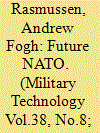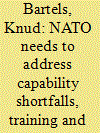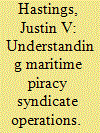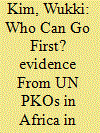| Srl | Item |
| 1 |
ID:
133366


|
|
|
|
|
| Publication |
2014.
|
| Summary/Abstract |
Two years ago, at our NATO Summit in Chicago. NATO leaders endorsed the review of NATO's deterrence and defence posture (D&DP).
|
|
|
|
|
|
|
|
|
|
|
|
|
|
|
|
| 2 |
ID:
133365


|
|
|
|
|
| Publication |
2014.
|
| Summary/Abstract |
The alliance withstood the test of the cold war and created the secure environment which allowed the EU to developed. NATO will continue to play a key role to keep our nations safe and help keep the world secure.
|
|
|
|
|
|
|
|
|
|
|
|
|
|
|
|
| 3 |
ID:
133367


|
|
|
|
|
| Publication |
2014.
|
| Summary/Abstract |
Given the proximity of the summit and preceding ministerial meetings, the significance of recent events in Ukraine and the shift in NATO's posture from being engaged in operations to being prepared for operations, this gathering has been extremely important for us.
|
|
|
|
|
|
|
|
|
|
|
|
|
|
|
|
| 4 |
ID:
116243


|
|
|
|
|
| Publication |
2012.
|
| Summary/Abstract |
In this article, I explain maritime piracy syndicates' structure and behavior as based on two required inputs: the time needed between an attack and the realization of profit, and access to certain economic and security goods, namely a secure environment and market infrastructure. Pirates face two challenges. Internally, they must keep the organization together during the operation, a challenge I examine with a principal-agent framework to show how the inputs shape the security and control tradeoffs that exist, or not. Externally, pirates must maintain access to the external resources necessary for the success of their operation. I then turn to the adaptations in internal structure, targeting, and network connections that different types of pirate syndicates make to resolve principal-agent problems and external resource access problems during operations.
|
|
|
|
|
|
|
|
|
|
|
|
|
|
|
|
| 5 |
ID:
177857


|
|
|
|
|
| Summary/Abstract |
The peacekeeping literature has primarily documented correlations between peacekeeping operations (PKOs) and their effectiveness or has focused on the decisions of troop-contributing countries participating in PKOs. Unlike the extant research, this paper shifts the focus to the decision-making process within PKOs. More specifically, this paper focuses on the timing of peacekeeper deployment by investigating how contributor leaders are distinguished from contributor followers. To tackle this topic, I use deployment-map data from 13 UN PKOs in Africa from 1990 to 2016. When a leader country deploys to a region before other countries, the followers will thus face an incentive to free ride because waiting to deploy to the region until it is secure is less risky. In short, there is a second-mover advantage that induces other countries to delay deployment until much later in a given UN PKO’s designated deployment window. This study finds that countries that could deploy more troops at their initial time of deployment and that have many previous UN PKO experiences are more likely to be leaders. Results also suggest that contributors engaging in multiple UN PKOs contemporaneously are less likely to be leaders.
|
|
|
|
|
|
|
|
|
|
|
|
|
|
|
|